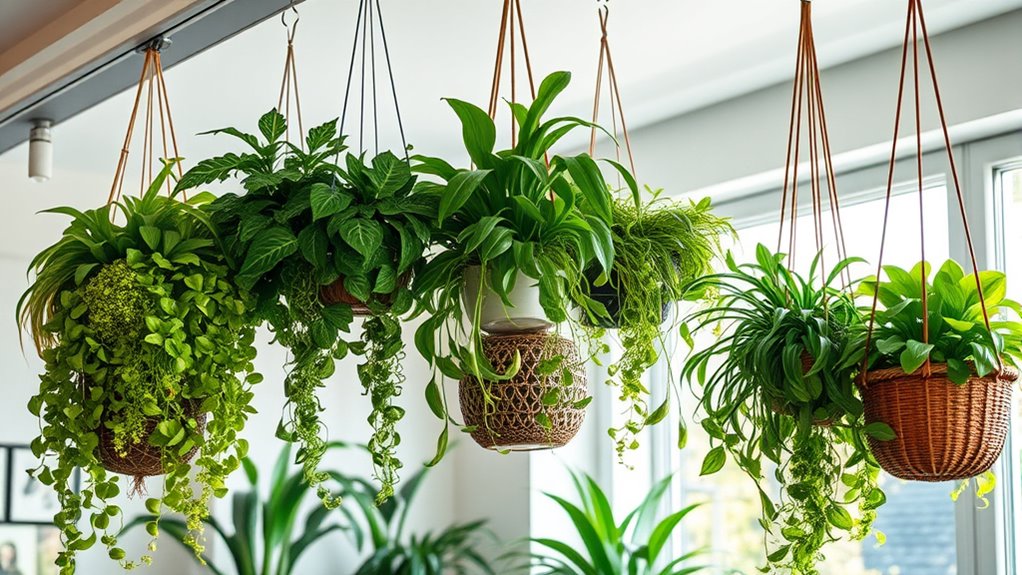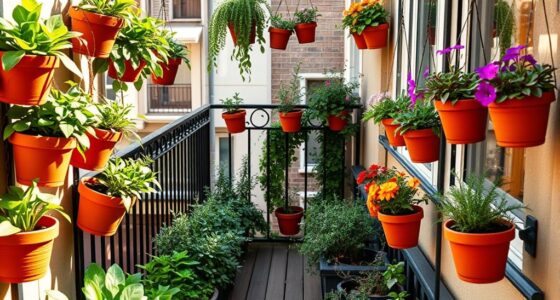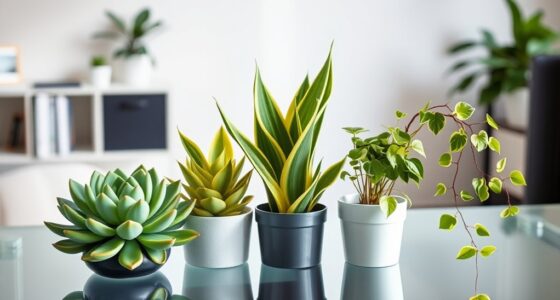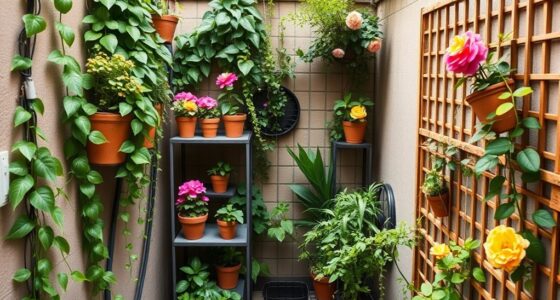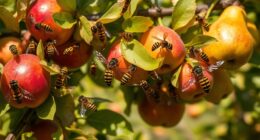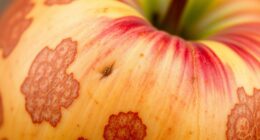If you’re looking to brighten your space with indoor hanging plants, there are options for every light level. Pothos and Philodendron Brasil thrive in low to bright indirect light, while Spider Plants and English Ivy handle various conditions. For brighter spots, try String of Hearts, String of Pearls, or Rhipsalis. Plants like Burro’s Tail and Lemon Button Fern suit shaded areas. Keep your environment in mind, and you’ll discover the best fit for your home with ease.
Key Takeaways
- Many indoor hanging plants like Pothos and Philodendron thrive in low to bright indirect light, making them versatile for various spaces.
- Propagation methods such as stem cuttings and plantlets allow easy sharing and growth of hanging plants.
- Proper care, including watering, pruning, and pest management, ensures healthy, vibrant trailing plants.
- Safety considerations vary; most popular hanging plants are non-toxic or pet-friendly, but some like Pothos require caution.
- The selection of plants depends on light levels, with adaptable options suitable for shaded, indirect, or bright environments.
Pothos (Epipremnum Aureum)
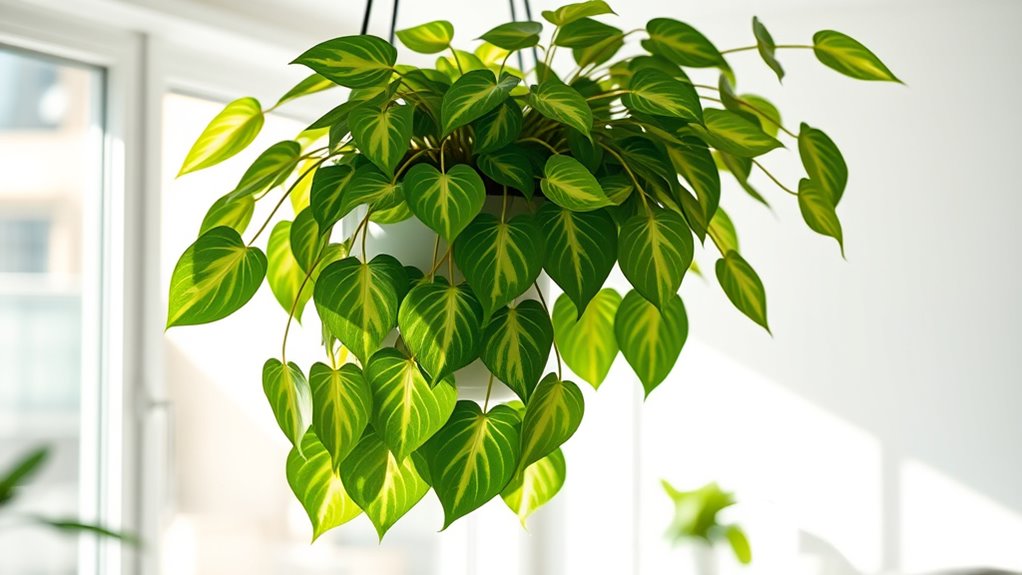
Pothos (Epipremnum aureum) is a popular choice for indoor hanging plants because of its easy care and attractive trailing vines. If you want to expand your plant collection, plant propagation comes easily through stem cuttings, which root quickly in water or soil. However, it’s important to consider toxic plant considerations, especially if you have pets or children. Pothos contains calcium oxalate crystals that can cause irritation or discomfort if ingested, so keep it out of reach. Despite its toxicity, many find its resilient nature and low maintenance requirements make it ideal for beginners. Regular pruning encourages bushier growth, and proper propagation ensures you can share or multiply your plant effortlessly. Just remember to handle it with care to avoid accidental ingestion. Understanding plant toxicity is essential for safe indoor gardening, and using self watering plant pots can help maintain optimal moisture levels for your plants. Additionally, choosing the right indoor lighting conditions will help your pothos thrive and maintain its vibrant appearance.
Spider Plant (Chlorophytum Comosum)
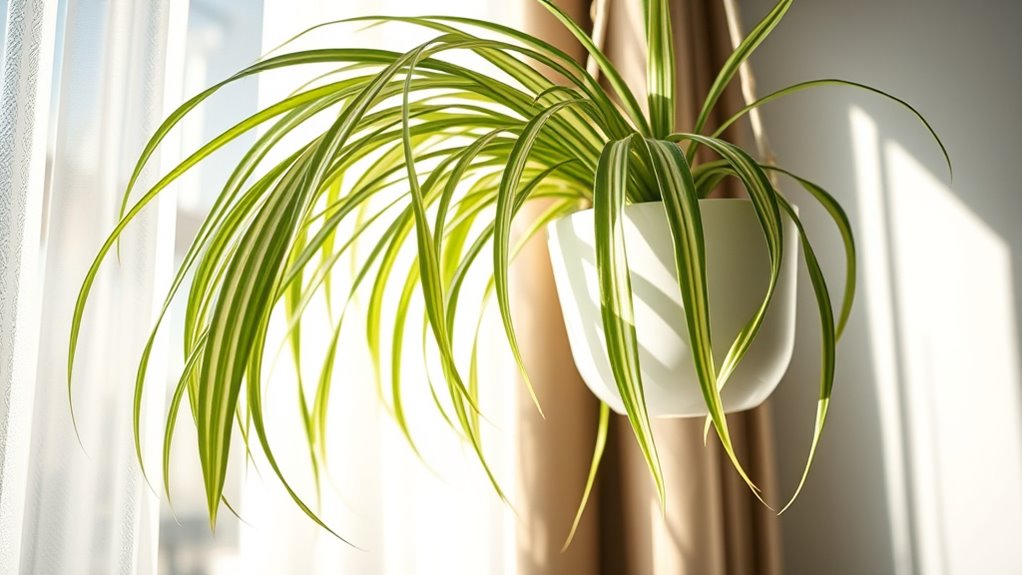
Have you considered adding a Spider Plant (Chlorophytum comosum) to your indoor hanging collection? This plant is a fantastic choice for improving indoor air purification, helping to filter toxins and keep your air fresh. Plus, it’s a pet-friendly plant, so you don’t need to worry if your furry friends get curious. The Spider Plant thrives in a variety of light conditions, from low to bright indirect light, making it versatile for different spaces. Its long, arching leaves and baby spiderettes add visual interest without much fuss. Easy to care for, it requires occasional watering and well-draining soil. Incorporating a Spider Plant into your home not only enhances your decor but also boosts air quality and safety for your pets.
English Ivy (Hedera Helix)

If you’re looking to add lush greenery that thrives in hanging arrangements, English Ivy (Hedera helix) is an excellent choice. This plant is known for its ability to improve indoor air quality by filtering toxins and pollutants. It’s easy to care for, making it perfect for beginners, and adapts well to various light levels, from low to bright indirect light. English Ivy’s plant growth rate is moderate, so it fills out quickly without becoming overwhelming. Its trailing vines add visual interest and can cascade gracefully from hanging baskets. Regular pruning encourages healthy growth and keeps it looking tidy. Incorporating plants like English Ivy into your space can also contribute to a more productivity-focused environment, especially in a home office setup. Additionally, English Ivy can help reduce airborne allergens, making it a beneficial choice for allergy sufferers. Overall, English Ivy is a versatile, air-purifying plant that brings lively greenery into your space while enhancing indoor air quality.
Philodendron Brasil (Philodendron Hederaceum ‘Brasil’)
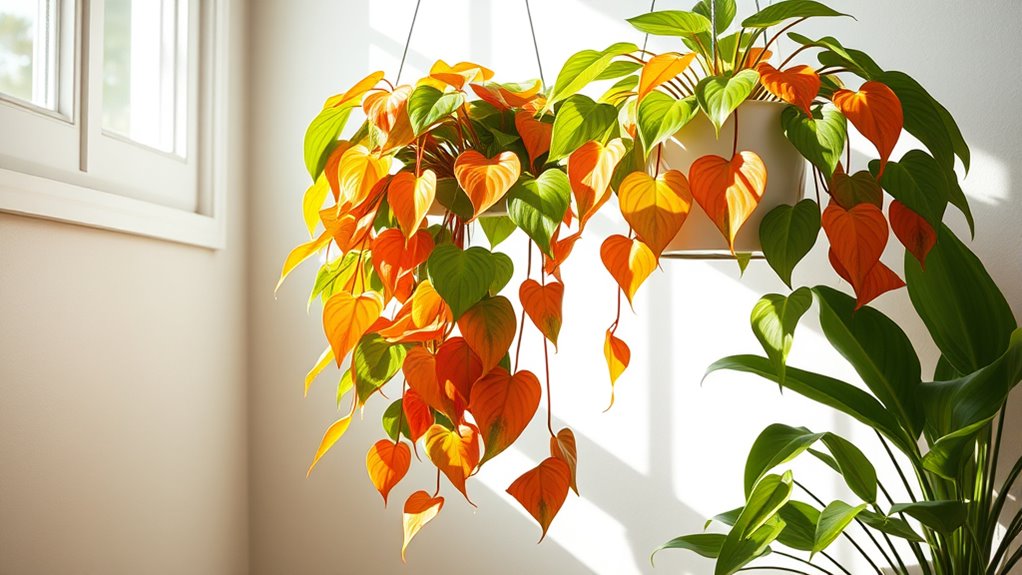
The Philodendron Brasil offers vibrant, variegated foliage that adds a splash of color to your space. It thrives in low light conditions, making it perfect for shaded corners or indoor areas with limited sunlight. Plus, its easy-care nature means you can enjoy its beauty without much fuss. Additionally, understanding color accuracy can help you select plants that display their true hues more vividly under different lighting conditions, especially when considering lighting conditions for optimal plant health. Proper lighting can also influence a plant’s growth rate, ensuring it remains healthy and vibrant over time.
Vibrant Foliage Variations
Are you looking to add a splash of color to your indoor garden? The Philodendron Brasil offers vibrant foliage variations that brighten any space. Its foliage color features striking green and yellow streaks, making it stand out among other plants. The leaf shape is heart-shaped with smooth edges, adding to its visual appeal. This plant’s lively foliage can energize your room and complement various décor styles. To maximize its vibrant look, place it where it gets bright, indirect light. Keep an eye on its foliage color, which can deepen or brighten depending on light levels. Proper care and maintenance can help ensure the plant stays healthy and vibrant. For example, understanding the importance of light requirements can significantly influence the plant’s coloration and growth. Additionally, watering habits play a crucial role in maintaining its health and vibrant appearance. With its unique leaf shape and colorful foliage, Philodendron Brasil is a perfect choice for bringing lively, variegated greenery into your home.
Low Light Tolerance
Philodendron Brasil is well-suited for low-light environments, making it an ideal choice for shaded corners and less sunny rooms. When considering plant placement, it thrives where light intensity is minimal, such as behind furniture or near north-facing windows. This plant adapts easily to indirect light, so you don’t need to worry about direct sun exposure. Its vibrant, variegated leaves can brighten up darker spaces without requiring bright, direct sunlight. Keep in mind that while Philodendron Brasil tolerates low light well, it still needs some ambient light to stay healthy. Avoid placing it in complete darkness, as that can hinder growth. Additionally, light levels influence plant health, and understanding industry trends can help you better position your plants for optimal growth in various environments. Recognizing how light availability impacts plant growth can further enhance your indoor gardening success.
Easy Care Requirements
Because it’s known for its resilience, Philodendron Brasil is one of the easiest indoor plants to care for. It requires minimal attention, making it perfect for beginners. When it comes to watering needs, let the top inch of soil dry out before watering again to prevent overwatering. This plant prefers well-draining soil that retains some moisture but doesn’t stay soggy. Keep it in bright, indirect light for vibrant foliage, but it can tolerate lower light levels. Additionally, using a well-draining soil mix with peat, perlite, or pine bark helps prevent root rot and supports healthy growth.
String of Hearts (Ceropegia Woodii)

Have you ever admired the delicate, trailing beauty of a String of Hearts (Ceropegia Woodii)? Its graceful, heart-shaped leaves cascade beautifully from hanging baskets, making it a perfect indoor accent. To keep yours thriving, focus on plant propagation by taking cuttings and encouraging new vines to grow. This plant prefers bright, indirect light but can adapt to lower levels, making it versatile for various indoor spaces. Regular pest management is essential; watch out for mealybugs and spider mites, and treat infestations promptly with insecticidal soap. Guarantee proper watering—allow the soil to dry out between sessions—and provide well-draining soil to prevent root rot. Additionally, understanding its light requirements can help optimize growth and health. Ensuring proper watering habits can significantly impact the plant’s overall vitality. Recognizing the importance of indoor gardening techniques can help you create the ideal environment for your String of Hearts. With the right care, your String of Hearts will flourish and add a touch of elegance to your home.
Boston Fern (Nephrolepis Exaltata)
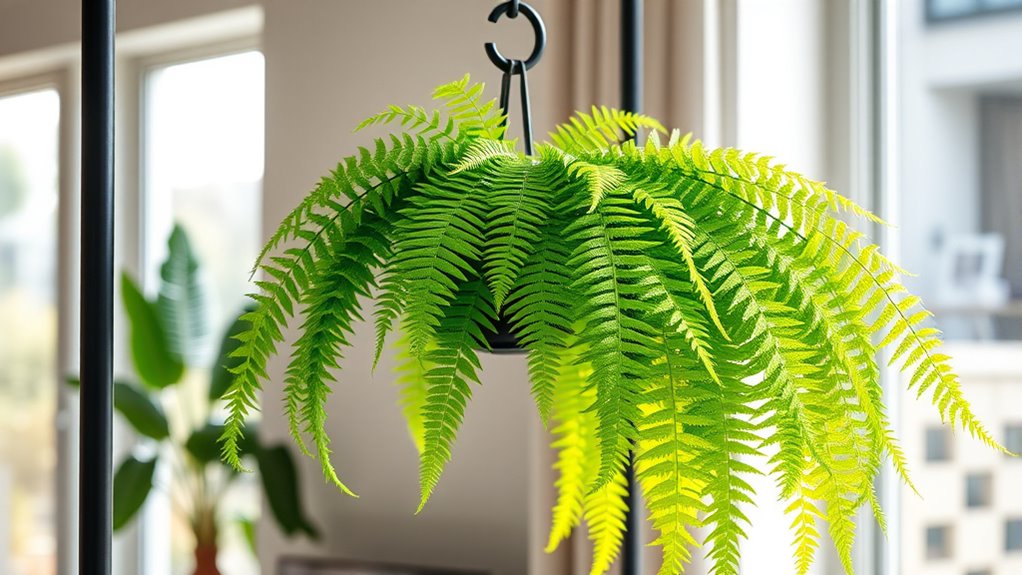
Boston Ferns thrive in bright, indirect light, so place yours near a window with filtered sunlight. Keep the soil consistently moist, but avoid overwatering, and maintain high humidity levels around the plant. Proper attention to these care points will guarantee your fern stays lush and healthy indoors. Incorporating natural materials in your plant setup can also enhance its growth environment. Additionally, using appropriate soil mixes that retain moisture well can support healthy root development.
Optimal Light Requirements
While Boston Ferns thrive in bright, indirect light, they can also adapt to lower light conditions if necessary. Proper plant placement is key to ensuring your fern stays healthy. Ideally, position it near a window with filtered natural light, avoiding direct sun that can scorch its delicate fronds. If your space has limited natural light, place the fern where it gets consistent, indirect illumination. This will help maintain lush foliage without stressing the plant. Remember, too little light can cause the fern to become sparse, while too much direct sun can burn its leaves. To optimize growth, keep an eye on the lighting conditions and adjust plant placement accordingly. The right balance of natural light will keep your Boston Fern thriving indoors.
Watering and Humidity Tips
Providing the right amount of water and humidity is essential for keeping your Boston Fern healthy and vibrant. Stick to consistent watering schedules, ensuring the soil stays evenly moist but not soggy. During warmer months, you may need to water more frequently, while in cooler months, reduce watering to prevent overwatering. Humidity levels are equally important; Boston Ferns thrive in high humidity. To boost humidity, mist the fronds regularly, place a humidifier nearby, or set the pot on a tray with pebbles and water. Avoid letting the plant sit in dry air or waterlogged soil. Monitoring soil moisture and adjusting your watering and humidity routines accordingly helps your fern stay lush and resilient indoors.
Maidenhair Fern (Adiantum Spp.)
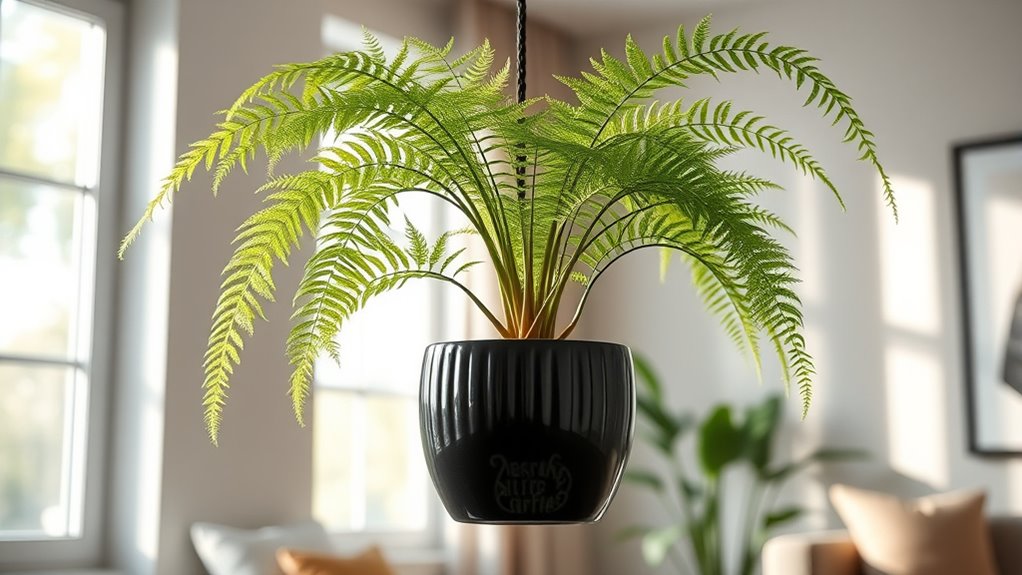
The Maidenhair Fern (Adiantum Spp.) is a delicate, airy plant that adds a touch of elegance to any indoor space. Its lacy fronds thrive in indirect light and require consistent moisture. To keep it healthy, focus on proper soil drainage and humidity levels. You can propagate this fern through plant propagation by dividing rhizomes or spores, but be gentle to avoid damage. Make certain the pot has drainage holes to prevent waterlogging, which can cause root rot. Maintain high humidity by misting regularly or placing a tray of water nearby. This fern prefers consistently moist soil, so water when the top inch feels dry. With proper care, you’ll enjoy its graceful foliage for years to come.
The Maidenhair Fern adds elegant, lacy foliage in indirect light with moist, well-draining soil.
- Use well-draining soil for ideal growth
- Keep soil consistently moist but not soggy
- Propagate through division or spores
Chinese Money Plant (Pilea Peperomioides)

The Chinese Money Plant (Pilea Peperomioides) offers a compact and attractive addition to any indoor space, complementing the delicate ferns with its bold, round, coin-shaped leaves. Its unique appearance makes it a versatile choice for indoor plant styling, whether on shelves, tabletops, or hanging baskets. To keep it thriving, establish simple plant care routines: place it in bright, indirect light, water when the top inch of soil feels dry, and avoid overwatering. This plant prefers well-draining soil and moderate humidity. Its low-maintenance nature makes it ideal for beginners and experienced plant lovers alike. Incorporate it into your decor to add a touch of greenery and visual interest, while effortlessly maintaining its health with consistent, mindful care.
Heartleaf Philodendron (Philodendron Cordatum)

Heartleaf Philodendron (Philodendron cordatum) is a versatile and easy-to-care-for indoor plant that adds lush greenery to any space. Its heart-shaped leaves cascade beautifully from hanging baskets, making it perfect for low-light or bright spots. Not only does it enhance your decor, but it also helps with air purification, improving indoor air quality. Plus, it’s a pet-friendly plant, so you can enjoy greenery without worry if you have curious pets. To keep it healthy, water when the top inch of soil feels dry, and provide indirect sunlight. Its trailing growth makes it ideal for hanging containers.
- Purifies indoor air, creating a healthier environment
- Pet-friendly, safe around children and pets
- Thrives in low to bright indirect light
Hoya (Hoya Spp.)

Ever wondered how to add a touch of elegance to your indoor space? Hoya plants are perfect for that, with their beautiful, waxy leaves and charming clusters of star-shaped flowers. They thrive in a variety of light levels, making them versatile for hanging spots. To expand your collection, try plant propagation through cuttings—simply take a healthy stem, let it callus, and root it in soil or water. Regular pest management is essential; Hoyas can attract mealybugs or spider mites. Keep an eye out and treat infestations promptly with insecticidal soap or neem oil. Proper care and attention will reward you with a stunning, low-maintenance plant that elevates your decor while being easy to propagate and keep healthy.
Lipstick Plant (Aeschynanthus Radicans)
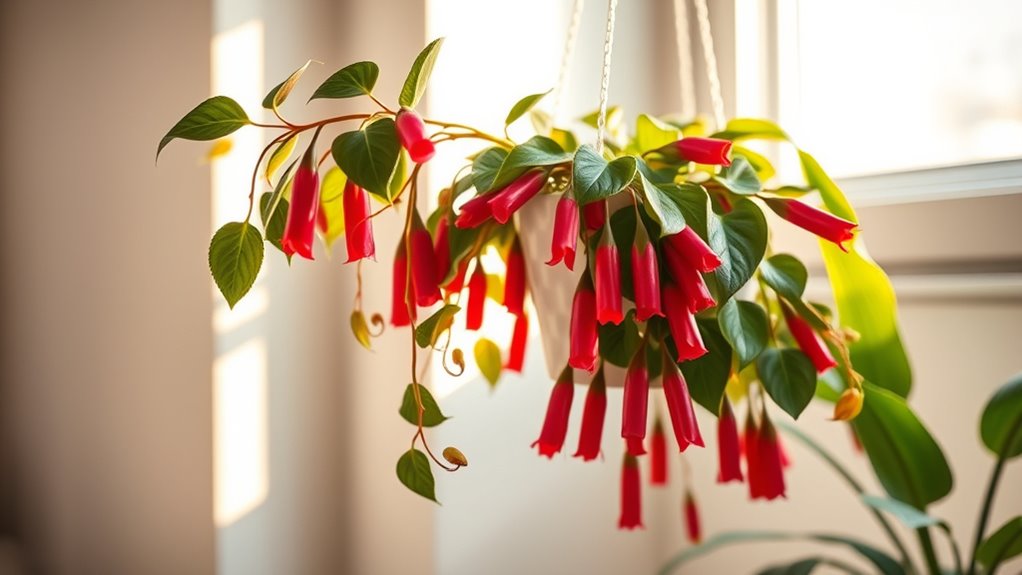
Add a splash of vibrant color to your indoor garden with the Lipstick Plant (Aeschynanthus radicans). This lively plant features colorful foliage and eye-catching, unique flower shapes that resemble lipstick tubes, making it a stunning focal point. Its trailing habit makes it perfect for hanging baskets, where its blooms can cascade freely. You’ll enjoy its ability to thrive in bright, indirect light, although it can adapt to lower levels with some care. The Lipstick Plant’s blooms last for several weeks, adding continuous color to your space. With minimal maintenance, it’s an ideal choice for beginners or those looking to add personality and vibrancy to their indoor collection.
- Vibrant, lipstick-shaped flowers
- Colorful foliage that pops
- Thrives in bright, indirect light
Burro’S Tail (Sedum Morganianum)

Burro’s Tail (Sedum morganianum) is a striking, low-maintenance succulent that brings unique texture and visual interest to your indoor hanging garden. Its trailing stems with plump, bluish-green leaves create a lush cascade perfect for potted plant design. You can easily propagate Burro’s Tail through plant propagation by stem cuttings—simply snip a healthy segment, let it callous for a day, then plant it in well-draining soil. This method makes it simple to expand your collection or share with friends. Its tolerance for bright, indirect light makes it ideal for various indoor spots, even those with limited sunlight. With minimal watering needs, Burro’s Tail fits seamlessly into your indoor garden, adding a natural, eye-catching element with little effort.
Rhipsalis (Rhipsalis Spp.)

Rhipsalis thrives in bright, indirect light but can tolerate lower levels of illumination. To keep it healthy, water it when the top inch of soil feels dry, and guarantee good drainage to prevent root rot. Its unique, trailing stems and delicate appearance make it a striking addition to your indoor space.
Ideal Light Conditions
Since Rhipsalis thrives in bright, indirect light, placing it near a window with filtered sunlight is ideal. Proper lighting design and plant placement are vital to keep your plant healthy and vibrant. Avoid direct sun, which can scorch its delicate stems, and instead, aim for consistent, gentle light. Indoors, a north or east-facing window works well, providing enough brightness without harsh rays. Remember, too little light can cause legginess, while too much can cause leaf burn. To optimize growth, consider using sheer curtains or placing the plant where it receives diffused sunlight. Positioning your Rhipsalis in spots with stable, indirect light ensures it flourishes, making it a stunning hanging feature in your indoor space.
Watering and Care Tips
To keep your Rhipsalis healthy and thriving, establishing a consistent watering schedule is vital. These plants prefer slightly moist soil but dislike waterlogged roots, so good soil drainage is essential. Water your Rhipsalis when the top inch of soil feels dry, typically every 1-2 weeks. During winter, reduce watering frequency. Ensure your pot has drainage holes to prevent water accumulation. Overwatering can lead to root rot, while underwatering causes stress. Use the following table as a quick guide:
| Watering Frequency | Soil Moisture Level | Notes |
|---|---|---|
| Weekly | Slightly moist | Adjust for indoor humidity |
| Every 2 weeks | Top inch dry | During cooler months |
| Monthly | Slightly moist | In low light conditions |
| As needed | Dry soil | Avoid soggy soil |
Proper watering and soil drainage keep your Rhipsalis healthy and vibrant.
Unique Plant Features
One of the most striking features of Rhipsalis species is their unique, trailing growth habit that sets them apart from many other indoor plants. This adaptation allows them to cascade beautifully from hanging baskets, creating a lush, natural look. Their slender, cylindrical stems are flexible, making them perfect for indoor environments with varying light conditions. Rhipsalis also has the remarkable ability to thrive in low-light areas, showcasing their indoor plant adaptations.
- Their trailing form adds visual interest and softens indoor spaces
- The cylindrical stems are drought-tolerant and low-maintenance
- They can adapt to different humidity levels, making them versatile for various rooms
Lemon Button Fern (Nephrolepis Cordifolia ‘Duffii’)
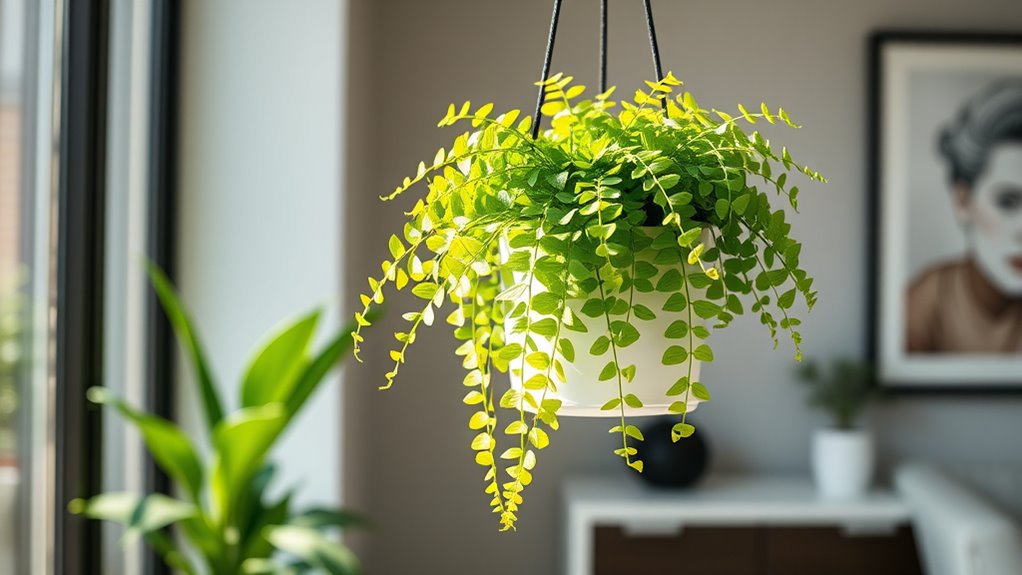
The Lemon Button Fern (Nephrolepis cordifolia ‘Duffii’) adds a vibrant touch to any indoor space with its compact size and lush, bright green foliage. This fern not only enhances your decor but also improves indoor air quality, making your environment healthier. It’s a great choice if you want a lush, low-maintenance plant that thrives in indirect light. When considering pet safety, keep in mind that the Lemon Button Fern is non-toxic to most pets, offering peace of mind if your furry friends like to nibble plants. Its dense, bushy appearance makes it an eye-catching addition without posing a risk to your pets. With proper care, this fern stays vibrant and fresh, creating a lively, safe, and air-purifying indoor space.
String of Pearls (Senecio Rowleyanus)
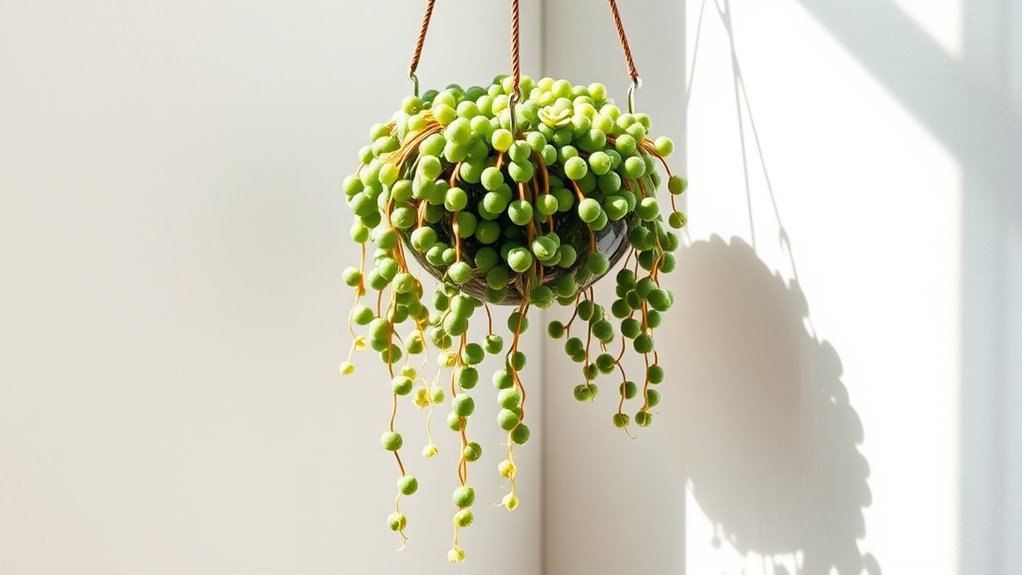
Adding a unique, eye-catching element to your indoor garden, the String of Pearls (Senecio rowleyanus) features trailing stems adorned with small, round, bead-like leaves that resemble pearls. This succulent thrives in bright, indirect light and requires minimal watering. To encourage plant propagation, you can easily root cuttings in soil or water, making it a fun way to expand your collection. Regular pest management is essential; keep an eye out for mealybugs and spider mites, which can damage the plant. Make certain good airflow and avoid overwatering to prevent issues. With proper care, your String of Pearls will cascade beautifully and stay healthy.
- Learn how to propagate your plant successfully
- Recognize and manage common pests effectively
- Maintain the right watering and lighting conditions
Frequently Asked Questions
How Often Should I Water Indoor Hanging Plants?
You should water indoor hanging plants based on their watering frequency and soil moisture levels. Check the soil regularly—when the top inch feels dry, it’s time to water. Typically, most plants need watering once a week, but this can vary with light levels and humidity. Avoid overwatering by ensuring excess water drains well, and always adjust your routine if the soil stays moist longer or dries out quickly.
Can These Plants Survive in Low Humidity Environments?
Many indoor hanging plants have varying humidity tolerance levels. If your space has low humidity, look for plants that thrive in dry air, like succulents or pothos. You’ll need to modify your plant hydration carefully, watering less frequently to prevent root rot. While some plants can adapt to low humidity, choosing varieties suited for drier environments ensures they stay healthy and vibrant.
Do Indoor Hanging Plants Require Fertilization?
You’re spot on to ask if indoor hanging plants need fertilization; it’s like watering a plant’s needs. Most plants require fertilizer schedules to thrive, ensuring proper plant nutrition. Regular feeding helps your plants stay healthy and vibrant, especially during active growth. While some may need less, generally, feeding every few months keeps your hanging garden lush. Think of it as giving your plants a little boost to stay happy and lively.
How Do I Prune and Maintain These Plants?
To prune and maintain your indoor hanging plants, start with proper pruning techniques by trimming dead or yellowing leaves to promote healthy growth. Use clean, sharp scissors or shears, and avoid over-pruning. Regularly inspect your plants for pests, practicing pest management by removing any insects and applying natural treatments if needed. Consistent care keeps your plants vibrant, healthy, and looking great, ensuring they thrive indoors.
Are These Plants Toxic to Pets?
Like a cautious cat, you want to guarantee pet safety around your plants. You should check each plant’s toxicity level because some indoor hanging plants can be harmful to pets. Knowing which plants are safe helps prevent accidental poisoning. Always research plant toxicity, and consider pet-friendly options to keep your furry friends safe. Your goal is to create a beautiful, safe space where both plants and pets can thrive.
Conclusion
So, with these 15 indoor hanging plants, you’re practically set for any light level — even if your space is as gloomy as your Monday mornings. Who knew that thriving greenery could be so effortless? Just remember, even the most resilient plants sometimes need a little love and a dash of luck. After all, it’s only a matter of time before your new leafy friends outshine your indoor decor — or at least try to.
